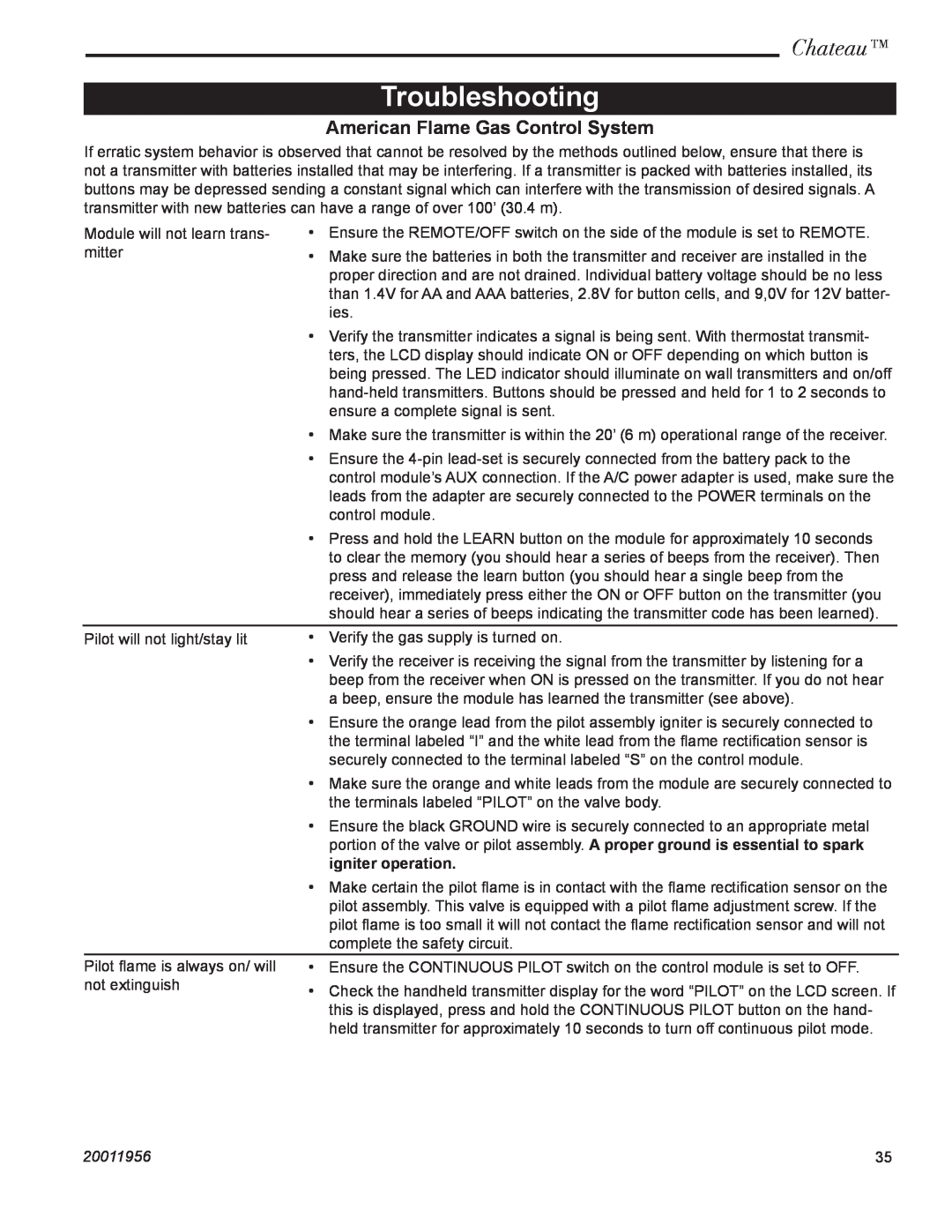
Chateau™
Troubleshooting
American Flame Gas Control System
If erratic system behavior is observed that cannot be resolved by the methods outlined below, ensure that there is not a transmitter with batteries installed that may be interfering. If a transmitter is packed with batteries installed, its buttons may be depressed sending a constant signal which can interfere with the transmission of desired signals. A transmitter with new batteries can have a range of over 100’ (30.4 m).
Module will not learn trans- mitter
•Ensure the REMOTE/OFF switch on the side of the module is set to REMOTE.
•Make sure the batteries in both the transmitter and receiver are installed in the proper direction and are not drained. Individual battery voltage should be no less than 1.4V for AA and AAA batteries, 2.8V for button cells, and 9,0V for 12V batter- ies.
•Verify the transmitter indicates a signal is being sent. With thermostat transmit- ters, the LCD display should indicate ON or OFF depending on which button is being pressed. The LED indicator should illuminate on wall transmitters and on/off
• Make sure the transmitter is within the 20’ (6 m) operational range of the receiver.
• Ensure the
| • Press and hold the LEARN button on the module for approximately 10 seconds |
| to clear the memory (you should hear a series of beeps from the receiver). Then |
| press and release the learn button (you should hear a single beep from the |
| receiver), immediately press either the ON or OFF button on the transmitter (you |
| should hear a series of beeps indicating the transmitter code has been learned). |
|
|
Pilot will not light/stay lit | • Verify the gas supply is turned on. |
| • Verify the receiver is receiving the signal from the transmitter by listening for a |
| beep from the receiver when ON is pressed on the transmitter. If you do not hear |
| a beep, ensure the module has learned the transmitter (see above). |
| • Ensure the orange lead from the pilot assembly igniter is securely connected to |
| the terminal labeled “I” and the white lead from the flame rectification sensor is |
| securely connected to the terminal labeled “S” on the control module. |
| • Make sure the orange and white leads from the module are securely connected to |
| the terminals labeled “PILOT” on the valve body. |
| • Ensure the black GROUND wire is securely connected to an appropriate metal |
| portion of the valve or pilot assembly. A proper ground is essential to spark |
| igniter operation. |
| • Make certain the pilot flame is in contact with the flame rectification sensor on the |
| pilot assembly. This valve is equipped with a pilot flame adjustment screw. If the |
| pilot flame is too small it will not contact the flame rectification sensor and will not |
| complete the safety circuit. |
Pilot flame is always on/ will | • Ensure the CONTINUOUS PILOT switch on the control module is set to OFF. |
not extinguish | • Check the handheld transmitter display for the word “PILOT” on the LCD screen. If |
| |
| this is displayed, press and hold the CONTINUOUS PILOT button on the hand- |
| held transmitter for approximately 10 seconds to turn off continuous pilot mode. |
20011956 | 35 |
